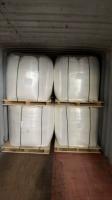Our Products
Polyacrylamide / anionic polyacrylamide praestol 2639 can be replaced by Chinafloc A series

Main Application of Anionic Polyacrylamide (Praestol 2639): A 980-Word Overview
Anionic polyacrylamide, particularly Praestol 2639, is widely used as a high-performance flocculant in various industries, primarily for its exceptional ability to assist in solid-liquid separation processes. Its effectiveness, especially in municipal and industrial wastewater treatment, makes it a key solution in environmental protection and process efficiency. This document elaborates on the main application of Praestol 2639—wastewater treatment, while also highlighting other supportive uses that contribute to its overall industrial significance.
Introduction to Anionic Polyacrylamide (Praestol 2639)
Praestol 2639 is a high molecular weight, water-soluble polymer based on polyacrylamide with an anionic charge density. It is typically supplied in the form of a white powder or milky emulsion. Due to its structure, it is designed to bind with positively charged suspended particles in water systems, thus enabling aggregation into larger flocs. These flocs can be separated from water through sedimentation, flotation, or filtration.
Key properties of Praestol 2639 include:
-
Anionic charge density: Moderate to high
-
Molecular weight: Very high (typically above 10 million Daltons)
-
Solubility: Readily soluble in water
-
Application method: Usually dosed after proper dissolution and dilution
Primary Application: Wastewater Treatment
The most important and dominant application of Praestol 2639 is in wastewater treatment. It is used extensively in both municipal and industrial sectors to treat effluent, clarify water, and dewater sludge. This polymer works by attracting suspended particles, binding them, and facilitating their removal.
1. Municipal Wastewater Treatment
Municipal wastewater contains organic and inorganic materials, suspended solids, and pathogens. Anionic polyacrylamide like Praestol 2639 is used in the following ways:
-
Primary sedimentation: Enhances the settling of suspended solids in primary clarifiers.
-
Sludge thickening: Helps concentrate sludge before digestion or dewatering, reducing volume and improving processing efficiency.
-
Sludge dewatering: Used with centrifuges, belt filter presses, and screw presses to produce a dry cake for easier disposal or incineration.
-
Effluent polishing: Reduces turbidity and fine particles in tertiary treatment, improving the clarity and quality of final discharged water.
Its high molecular weight and charge facilitate rapid and dense floc formation, which settles quickly and improves overall plant performance.
2. Industrial Wastewater Treatment
In industrial operations, wastewater varies in composition depending on the process. Anionic polyacrylamide (Praestol 2639) is applied in:
-
Textile and dyeing: Removes color, suspended solids, and organic material.
-
Pulp and paper mills: Treats white water and clarifies effluent, helping recycle water and reduce BOD.
-
Chemical plants: Aids in separating solids and reducing pollutants in chemical effluents.
-
Food processing: Helps remove organic solids, fats, and proteins in slaughterhouses, breweries, and dairy factories.
-
Oil refineries: Assists in the removal of residual hydrocarbons and suspended contaminants.
In all these cases, Praestol 2639 improves effluent quality, reduces chemical consumption, and supports compliance with environmental regulations.
Mechanism of Action
Praestol 2639 works through the following mechanisms:
-
Charge interaction: Its anionic chains neutralize and destabilize positively charged colloids in the water.
-
Bridging: Long polymer chains link multiple particles together, forming larger, denser flocs.
-
Sedimentation or flotation: The large flocs formed settle under gravity or float (if entrapped with gas), allowing for easy removal.
This process significantly enhances sedimentation rates and improves filtration performance.
Advantages in Wastewater Treatment
Using Praestol 2639 in wastewater treatment offers multiple benefits:
-
Improved sludge dewatering: Produces drier sludge cake, reducing disposal volume and cost.
-
Reduced chemical load: Works efficiently at lower dosages compared to inorganic coagulants.
-
Faster sedimentation: Accelerates clarification processes and reduces retention time.
-
Wide pH range: Effective across pH 4 to 9, making it suitable for various water chemistries.
-
Cost-effectiveness: Reduces energy consumption, labor, and chemical use in water treatment operations.
Its high-performance characteristics ensure stable results even under varying flow rates and contaminant loads.
Other Industrial Applications
While wastewater treatment is the core application of Praestol 2639, it is also used in other processes that involve solid-liquid separation:
a. Mining and Metallurgy
In mineral processing plants, Praestol 2639 is used to:
-
Settle fine tailings
-
Clarify process water
-
Improve thickener efficiency
b. Paper and Pulp
Praestol 2639 plays a role in:
-
Paper machine white water treatment
-
Sludge treatment from paper mills
-
Enhancing retention and drainage on paper machines
c. Oil and Gas
In oilfield applications, anionic polyacrylamide is used in:
-
Produced water treatment
-
Drilling mud clarification
-
Enhanced oil recovery (EOR) systems where water mobility control is necessary
Dosage and Handling
Typical dosage: 1–10 ppm depending on the nature of the water and the concentration of solids.
Preparation:
-
Powder must be mixed with water to form a 0.1–0.5% solution.
-
Emulsions require mechanical inversion before use.
Storage:
-
Keep in a dry, cool, well-ventilated place.
-
Avoid moisture contact for powdered products.
-
Emulsion shelf life is around 6–12 months depending on storage conditions.
Proper dissolution and dispersion are key to optimal performance.
Safety and Environmental Considerations
-
Toxicity: Low when used as directed; residual acrylamide monomer content is usually well below regulated limits.
-
Biodegradability: The polymer backbone is not easily biodegradable, but it can be separated along with sludge for safe disposal.
-
Handling: Requires use of PPE (gloves, goggles) to avoid irritation and inhalation of dust.
Praestol 2639 must be handled according to local safety regulations and manufacturer instructions.





